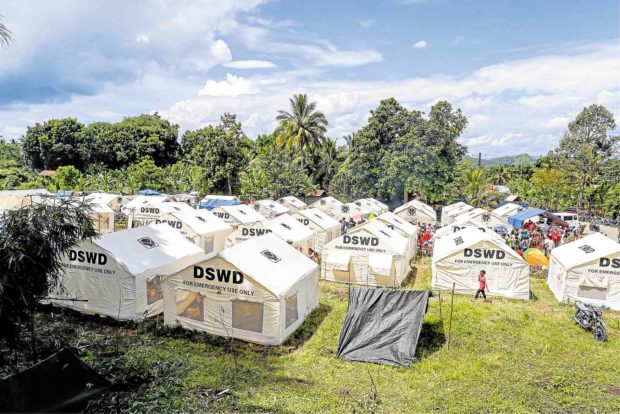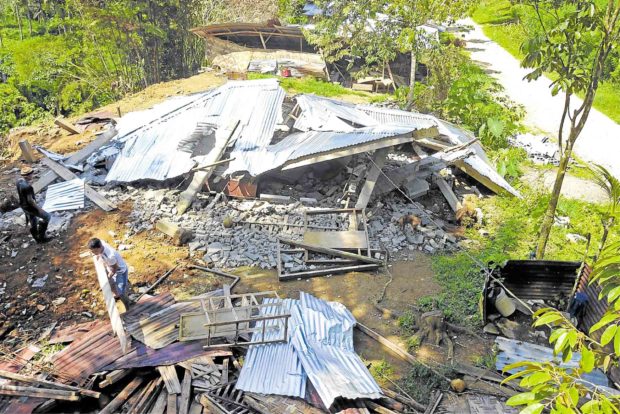Trauma from quake stalls rebuilding

TEMPORARY HOMES Government-donated tents are set up at the grounds of Makilala Elementary School in Cotabato to serve as temporary homes of residents displaced by recent earthquakes. JEOFFREY MAITEM
KIDAPAWAN CITY, Cotabato, Philippines — On Friday last week, four friends huddled to catch up on each other in a downtown coffee shop in this earthquake-hit city.
The series of quakes last month have drawn the three of them back to Kidapawan to check on their respective families.
Suddenly, a magnitude 4 tremor struck at 6:16 p.m. Two minutes later, another was felt, which the Philippine Institute of Volcanology and Seismology measured at 3 magnitude.
In an instant, one of the four, who still lives here, stood up and prepared to run out of the coffee shop. Although she was prevailed upon to stay, it took several minutes to calm her down.
“You should understand why I acted that way. Given our experience here with the three [major] quakes, it is hard to take chances,” said the woman, who wanted to be identified only as Christine.
Article continues after this advertisementShe said that up to now, her family and their neighbors, whose houses had been spared from damage and cracks, slept either in a tent or in a makeshift shelter made of tarpaulin.
Article continues after this advertisementThe practice is prevalent in the quake-hit areas of Cotabato province where local officials are trying to turn around the situation and rise above the massive devastation wrought on their communities by the series of tremors.
Homeless
Government data showed that 5,406 houses had either been damaged or destroyed in the city’s 40 villages. Of these, 1,602 were classified as “totally wrecked.”
More than 2,700 families were rendered homeless by the earthquake, with most of them living in Barangay Ilomavis, a village at the foot of Mt. Apo, where landslides were noted. They are staying in 21 evacuation sites spread out in eight villages.
On Friday, Kidapawan Mayor Joseph Evangelista walked into the City Hall, which had been closed since Oct. 29, and led structural engineers who assessed the building’s integrity.
The engineers allowed local officials to use the City Hall, prompting Evangelista to order a cleanup and renovation over the weekend.
“I want to lead by example. I will reopen my office on Monday,” according to Evangelista, whose office is on the third floor. “It is important to erase the stigma.”
Reopening businesses
Evangelista said a good indication that the stigma was gone was when families, whose houses had not been damaged, would spend the night in their houses.
In the meantime, Evangelista has focused on the reopening of businesses, asking owners to hasten the rehabilitation of their establishments and resume operations.

DAMAGE CHECK Residents of Barangay New Batasan in Makilala town, Cotabato province, return to their village to retrieve their belongings and salvage building materials after a strong earthquake destroyed their houses last month. —ERWIN MASCARIÑAS
As the province’s major economic hub, Kidapawan’s recovery would dictate the pace of rebuilding in nearby towns, like Makilala, the hardest-hit area.
A local mall, the city’s largest employer, remained closed, displacing at least 1,000 workers since Oct. 16.
The lack of potable water supply in the city has also become a major challenge in rebuilding. Only 6,000 of 26,000 households served by the water district currently get their supply after the distribution pipelines were busted by the tremors.
Damage assessment
Evangelista said the local government was looking at resettling close to 700 families, whose houses were damaged by the quake, back to their communities within the week. He expected the National Housing Authority to provide emergency housing assistance to these families so they could repair their homes.
This way, the evacuation sites would be decongested and the local government would be left looking after those who lost their homes and those who could not return to their communities which had been declared “no build zones.”